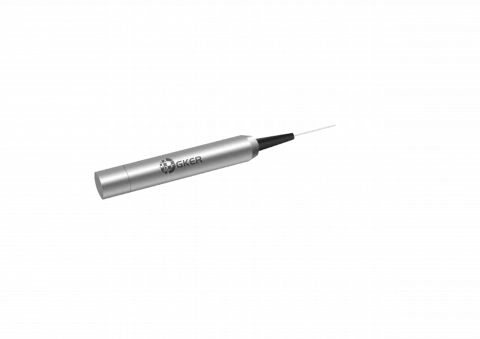1310-1480-1550nm Faraday Mirror
Description
The GKER Photonics Faraday Mirror (GK-FM Series) is a high-performance passive optical device designed to rotate the polarization state of incoming light by 90 degrees. Utilizing advanced Faraday Effect technology, this mirror provides precise polarization rotation with minimal insertion loss, ensuring optimal signal integrity in various optical applications. Its excellent environmental stability and low Polarization Dependent Loss (PDL) make it an ideal solution for use in Erbium-Doped Fiber Amplifiers (EDFAs), fiber lasers, and other fiber optic instruments where polarization effects need to be minimized.
The GK-FM Series Faraday Mirror is available in multiple wavelength options, including 1310 nm, 1480 nm, and 1550 nm, making it versatile for a wide range of optical systems. The device is built with SMF-28 fiber, ensuring high compatibility with standard optical systems. Additionally, it can handle continuous optical power up to 300 mW, making it suitable for high-power applications. With customizable fiber jackets and connector types, the GK-FM Series can be tailored to meet specific application requirements.
Whether in a laboratory setting or a high-speed communication network, the GK-FM Series Faraday Mirror offers reliable performance, helping to maintain signal quality by minimizing unwanted polarization effects. It is a vital component for any optical system that demands high precision and stability.
1310-1480-1550nm Faraday Mirror
Specifications |
|
|---|---|
| Center Wavelength: | 1310 nm |
| Operating Wavelength Range: | 1310 – 1550 nm |
| Typical Insertion Loss: | 0.4 dB |
| Max Insertion Loss: | 0.6 dB |
| Min Extinction Ratio: | Not Specified |
| Max Optical Power: | 300 mW |
| Center Wavelength: | 1310, 1480, 1550 nm |
| Operating Wavelength Range: | ± 15 nm |
| Typ. Insertion Loss: | 0.4 dB |
| Max. Insertion Loss: | 0.6 dB |
| Faraday Rotation Angle (Single Pass): | 45 degree |
| Max. Rotation Angle Tolerance, λc, 23 ℃: | ± 1 degree |
| Max.PDL: | 0.1 dB |
| Fiber Type: | SMF-28 Fiber - |
| Max.Optical Power: | 300 mW |
| Max. Tensile Load: | 5 N |
| Operating Temperature: | - 5 to + 70 ℃ |
| Storage Temperature: | - 40 to + 85 ℃ |
Features
- Precise Polarization Rotation: Achieves 90-degree polarization rotation with ±1-degree tolerance
- Low Insertion Loss: Offers typical insertion loss of 0.4 dB, ensuring minimal signal degradation
- High Environmental Stability: Operates reliably across a wide temperature range from -5°C to +70°C
- Low Polarization Dependent Loss (PDL): Provides maximum PDL of just 0.1 dB for optimal performance
- High Optical Power Handling: Capable of managing continuous optical power up to 300 mW
- Versatile Wavelength Options: Available for 1310 nm, 1480 nm, and 1550 nm wavelengths
Applications
- EDFA Systems: Ideal for use in Erbium-Doped Fiber Amplifiers, providing stable polarization control
- Fiber Lasers: Enhances performance by minimizing polarization effects in fiber laser systems
- Optical Instruments: Ensures accurate measurement and testing by maintaining consistent polarization
- High-Speed Communication Systems: Supports high-bandwidth communication systems requiring precise polarization management
For pricing, technical or any other questions please contact the supplier
- No registration required
- No markups, no fees
- Direct contact with supplier
-
Ships from:
China
-
Sold by:
-
On FindLight:
since 2024
Frequently Asked Questions
The Faraday Mirror rotates the polarization state of incoming light by 90 degrees, helping to minimize polarization effects in optical systems.
It supports 1310 nm, 1480 nm, and 1550 nm wavelengths, making it suitable for various optical systems.
The typical insertion loss is 0.4 dB, ensuring minimal signal degradation in optical systems.
The Faraday Mirror can handle continuous optical power up to 300 mW, making it suitable for high-power applications.
The Faraday Rotation Angle is 45 degrees per single pass, with a maximum tolerance of ±1 degree.
The device is built with SMF-28 fiber, which is compatible with standard optical systems.
Yes, it operates reliably within a temperature range of -5°C to +70°C and can be stored between -40°C and +85°C.
The maximum PDL is 0.1 dB, which helps maintain optimal performance in polarization-sensitive applications.
It enhances system performance by minimizing polarization effects, ensuring stable and accurate signal transmission in optical systems like EDFAs and fiber lasers.
Yes, it offers customizable options for wavelength, fiber jacket, connector type, and fiber length to meet specific application requirements.

